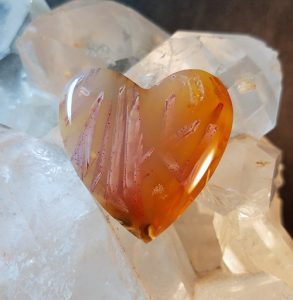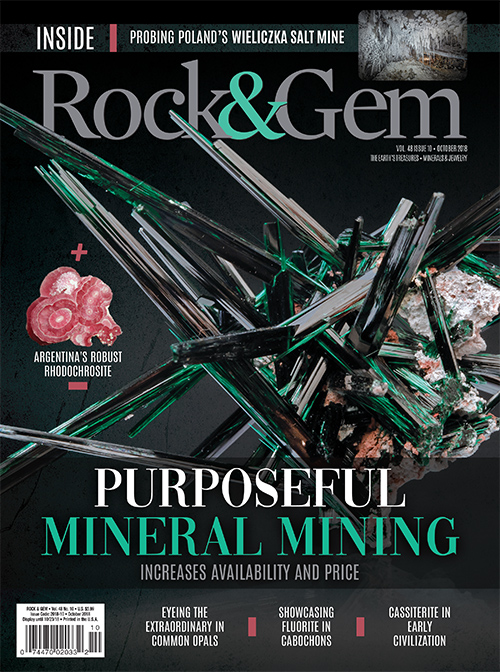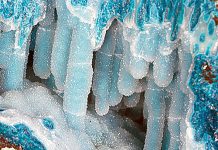
By Russ Kaniuth
For the last couple years, many different types of stones have been coming out of Indonesia that have made quite an impact in the lapidary world. The colorful fossil corals and Bumble Bee jasper have been widely used in making cabs. Now we are starting to see a whole new wave of stones, such as grape agate, feather agate, and even blue amber.
The one that caught my eye recently was the Indonesian Stick agate. It is beautiful, translucent, apricot-colored agate with streamers of color throughout the material. The streamers (sticks) usually have red to pink hues spraying in all directions.
Appeal of Apricot Agates

This material is coming from the mountain regions of Jambi, Sumatra. The miners have been digging down 16 to 20 feet, pulling what I would consider to be nodules out of the mountain. From the outside, the rough material all looks the same: a pale rind keeps you from seeing the patterns or coloring inside. When buying this material, I think it’s best to shop for pieces that have been windowed (a portion broke off to see the inside) or have one side face cut. This way, you assure yourself of getting good material with a lot of color and patterns.
Much of this material has a lot of small, drusy vugs inside of it, so expect it. You can use these drusy vugs as part of the design in your cabs, or you can easily cut around them. There will usually be more than enough room to create nice cabs from the areas free of vugs.
When starting out slabbing your rough, you may want to cut off an end or two to see which direction you want to see the patterns, but there’s not a great deal of difference, since the sticks are arranged in random directions. This material is a rather hard agate, so you may want to dress your blade before cutting your slabs.
Fine Fractures Call for New Approach
Another thing I have noticed is fine fractures within the material, which you have to look hard to find. This may be something to take notice of when cutting slabs; if the fractures are in the middle of the work, you may want to stop the direction you are cutting, turn the material, and cut in the opposite direction.
 Once you are ready to cut your preforms, this is where the fun begins. The stick sprays in various directions, but generally in clusters, so you can group a cluster spraying in one direction to design your cab around. Some clusters look like fireworks, others like pink palm trees, and still others just go in all directions, which gives the cab designer a lot to choose from!
Once you are ready to cut your preforms, this is where the fun begins. The stick sprays in various directions, but generally in clusters, so you can group a cluster spraying in one direction to design your cab around. Some clusters look like fireworks, others like pink palm trees, and still others just go in all directions, which gives the cab designer a lot to choose from!
Cabbing this particular agate isn’t much different than any other agates. Start on your 80 grit wheel to shape and dome your cab, and move on in the regular cabbing process. Small drusy vugs could come to the surface that you weren’t expecting, so this might be where you embrace that and continue cabbing with it as part of your design.
Stay the Course
The only thing to be aware of is in the final stage: If you choose to polish with cerium oxide, the polishing compound will fill the vugs and be hard to clean out, so it’s best to have a toothbrush and a small bucket of water nearby to get it out as soon as possible, before it hardens and becomes really difficult to remove later.
Author: Russ Kaniuth
 Is the owner of Sunset Ridge Lapidary Arts and the cofounder of the Cabs and Slabs Facebook group. View more of his work at www.sunsetridgelapidary.com.
Is the owner of Sunset Ridge Lapidary Arts and the cofounder of the Cabs and Slabs Facebook group. View more of his work at www.sunsetridgelapidary.com.
span>
If you enjoyed what you’ve read here we invite you to consider signing up for the FREE Rock & Gem weekly newsletter. Learn more>>>
In addition, we invite you to consider subscribing to Rock & Gem magazine. The cost for a one-year U.S. subscription (12 issues) is $29.95.Learn more >>>
















